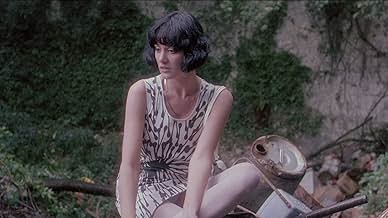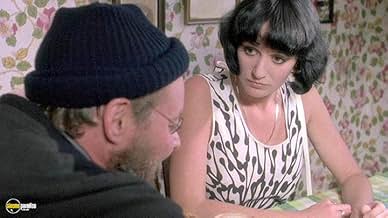In 1966, a woman has an enigmatic interaction with a stationmaster and his aide, setting off an intriguing chain of events that unfolds throughout the narrative.In 1966, a woman has an enigmatic interaction with a stationmaster and his aide, setting off an intriguing chain of events that unfolds throughout the narrative.In 1966, a woman has an enigmatic interaction with a stationmaster and his aide, setting off an intriguing chain of events that unfolds throughout the narrative.
Photos
Rik Mayall
- Policeman
- (uncredited)
Jeremy Watt
- Bowler
- (uncredited)
- Director
- Writer
- All cast & crew
- Production, box office & more at IMDbPro
Storyline
Did you know
- TriviaReleased in the UK as the support short to Dead & Buried (1981), initially in fifty screens in the ABC network in the North-East of England, later in the rest of the country.
- GoofsPolice are seen searching for the missing woman at night-time. Police searches are only ever carried out during daylight hours, as this obviously increases the chances of being able to find evidence.
Featured review
On Thursday 15th July 1982, I was at the Turnpike Lane ABC cinema (sadly since demolished) in North London to watch 'Dead and Buried' with its supporting short 'The Orchard End Murder' and today, exactly 39 years later (to both the date and day of the week) here I am writing a review of the latter of these two films, using technology that did not exist in 1982.
I can remember next to nothing of 'Dead and Buried' but 'The Orchard End Murder' has stuck in my mind for all these years, perhaps because of its British setting. Having missed the very occasional TV screening (which tended to be in the small hours) I was delighted to find out recently that the BFI have deemed the film worthy of restoration and preservation, no mean feat for a film lasting barely 50 minutes. Consequently, I purchased the DVD from them and viewed it last week for the first time in almost 39 years.
There are many bits I remember from 1982 - the killing of the rabbit (which turned out to be more convincing than I thought I had remembered) the murder itself (although I thought it had taken place on grass rather than a huge pile of apples) and in particular, the last two scenes of the film.
The film starts off well with a lot of good tension up to the appearance of Ewen, who at that point appears to be a good guy with a pet rabbit while the stationmaster appears to be creepy at best and a potential murderer at worst.
The sudden and unexpected killing of the rabbit is perhaps too realistic looking and if the director was trying to make a point in linking violence against animals with violence against humans, he still went perhaps a bit too far in this respect.
The murder itself, and the attempted rape that precedes it, is graphic and shocking, and more notably so for the fact that it involves a strangling rather than the more common shootings or stabbings usually seen in films. We are then later treated to an unusual display of necrophilia by the murderer as he attempts to hold on to the dead body with which he has fallen deeply in love with. It is a touching performance by Clive Mantle, but the film's somewhat misogynistic attitude would not sit well today. In fact, the film would probably not even get made in today's 'woke' society.
The film ends a little abruptly, but all the same it is a beautifully photographed film though that evokes a nostalgia for an England of steam trains and village cricket matches, which makes it worth watching.
I can remember next to nothing of 'Dead and Buried' but 'The Orchard End Murder' has stuck in my mind for all these years, perhaps because of its British setting. Having missed the very occasional TV screening (which tended to be in the small hours) I was delighted to find out recently that the BFI have deemed the film worthy of restoration and preservation, no mean feat for a film lasting barely 50 minutes. Consequently, I purchased the DVD from them and viewed it last week for the first time in almost 39 years.
There are many bits I remember from 1982 - the killing of the rabbit (which turned out to be more convincing than I thought I had remembered) the murder itself (although I thought it had taken place on grass rather than a huge pile of apples) and in particular, the last two scenes of the film.
The film starts off well with a lot of good tension up to the appearance of Ewen, who at that point appears to be a good guy with a pet rabbit while the stationmaster appears to be creepy at best and a potential murderer at worst.
The sudden and unexpected killing of the rabbit is perhaps too realistic looking and if the director was trying to make a point in linking violence against animals with violence against humans, he still went perhaps a bit too far in this respect.
The murder itself, and the attempted rape that precedes it, is graphic and shocking, and more notably so for the fact that it involves a strangling rather than the more common shootings or stabbings usually seen in films. We are then later treated to an unusual display of necrophilia by the murderer as he attempts to hold on to the dead body with which he has fallen deeply in love with. It is a touching performance by Clive Mantle, but the film's somewhat misogynistic attitude would not sit well today. In fact, the film would probably not even get made in today's 'woke' society.
The film ends a little abruptly, but all the same it is a beautifully photographed film though that evokes a nostalgia for an England of steam trains and village cricket matches, which makes it worth watching.
Details
Contribute to this page
Suggest an edit or add missing content

Top Gap
By what name was The Orchard End Murder (1981) officially released in Canada in English?
Answer



















